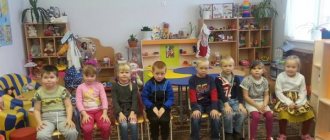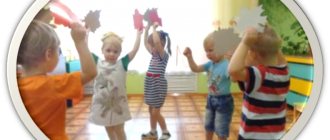Summary of GCD in the middle group “Golden Autumn”
Summary of educational activities for speech development in the middle group
"Golden Autumn"
Target
: expand the understanding of the surrounding nature
Tasks:
1. Learn to repeat and name the signs of autumn (the leaves are yellow, the sky is gray, it has become cool outside) 2. Activate children’s vocabulary on the topic “Golden Autumn” 3. Develop artistic perception, attention 4. Strengthen the skill glue the sheet to the paper 5. Develop the ability to work in a team
Integration of areas:
cognitive development, speech development, artistic and aesthetic development, physical development.
Preliminary work
: conversation about the signs of autumn, observing changes in nature while walking, reading fiction about autumn.
Contents of organized activities: 1. Organizational moment
Educator: Guys, today we will go to the autumn forest (leads to a picture depicting an autumn forest).
2. Main part.
Educator: Summer has passed, autumn has come.
In autumn it gets cold in the forest, the leaves on the trees are no longer green, but what are they? (look at the picture, the teacher shows yellow and red leaves). The sky in autumn is dark, there are clouds on it, it will probably rain. The wind blows and leaves fly off the trees. The teacher hands out pre-prepared maple leaves to the children, the children take them by the twig (leg). Then they carry out the breathing exercise “Blow the leaf away”: first they blow, do not let go of the leaf, hold it. Then they let go, the leaf flies. Educator: Well done! Look how beautifully the leaves fly, how beautifully the wind blows them from the trees. 3. Physical education minute
Take the fallen leaves in your hands, we will play the game “Whose leaves? ".
Turn around, spin around and turn into leaves (children spin around)
We are autumn leaves, colorful leaves (waving leaves)
We were sitting on branches, the wind blew, we flew (ran)
Leaves are flying in autumn, what is it? (children in chorus)
Leaf fall! (throw leaves)
Leaf fall, leaf fall, yellow leaves are flying, (waving)
The earth is covered, the earth is covered. (The children each run to their
leaf and squat).
4. Game "Leaf"
On the floor in a circle lie sheets 1 less than the number of children.
Children stand near them. While the tambourine is playing, the children run in a circle, the tambourine quiets down, you need to take a sheet from the floor. During the game, the number of leaves and children decreases. 5. Creating an autumn picture
Educator: Let's decorate our group.
I suggest making you an autumn picture from the leaves we played with today. Children glue the leaves onto a pre-prepared Whatman paper, which hangs on an easel. Children specify the color of the leaves and their size. Reflection
Children admire the picture, hang it in a corner of nature, and together remember what they did during class.
Publication address:
Abstract of GCD on the formation of a holistic picture of the world on the topic of Autumn in the middle group of preschool educational institutions
ECD for the formation of a holistic picture of the world in the middle group “Autumn has come to us”
Goal : developing children’s knowledge about autumn Tasks: 1. Continue to acquaint children with the signs of autumn; 2. Learn to distinguish between vegetables and fruits, mushrooms, birds; 3.Develop speech and cognitive activity; 4. Cultivate love for the world around us. Material: Pictures depicting autumn, dummies of vegetables and fruits, basket, vase, pictures of mushrooms, animals, birds, leaves (rowan, maple, oak, poplar, birch), baskets depicting trees Lesson progress
:
Teacher: Guys, let's say hello to nature around us. Good morning sun, Good morning sky, Good morning earth, Good morning to all of us. Let's sit with you on the carpet in a circle and listen to a story - a riddle. Listen carefully, and then try to guess what time we are talking about. (The story is read to the music of P.I. Tchaikovsky from the collection “The Seasons”). “The leaves rustled in the forest, and it seemed as if someone was walking under the maples and birches, and where they passed, the leaves turned red and golden. Now you won’t even recognize your native forest, your native clearing, your native lake. The flowers withered and withered, the grass turned yellow. Everyone was busy, everyone was preparing for the coming of winter. The birds took off from their places and flew in flocks to the warm blue seas.” (Excerpt from O. Ivanenko’s story “Good Night”) Educator: What time of year was this passage talking about? Let's look at pictures of autumn. - After what time of year does autumn come? Tell me about the signs of autumn. Educator: Guys, name the autumn months. (name, specify) - What happens in autumn in nature, in the life of animals and birds? (Children answer.) Educator: What do people do in gardens and vegetable gardens? (Children answer.) Game “Vegetables and Fruits” Purpose: to consolidate knowledge of vegetables and fruits. (You need to collect vegetables in a basket and fruits in a vase.) Educator: Well done with this task. Physical exercise “Leaves” (Children imitate the flight of autumn leaves) Educator: Tell me, do all the birds stay with us for the winter? What birds are called wintering? (bullfinch, sparrow, crow, woodpecker, siskin, pigeon) Educator : let's look at what the bird looks like, what does it have? (head, neck, tail, etc.). Educator: Tell us what birds eat in winter? Children: Tree seeds, larvae under the bark of trees. Educator: And people feed the birds. To do this, he makes feeders. Feed the birds in winter. Let flocks of people flock to your porch from all over, as if it were home. Their food is not rich. A handful of grain is needed, One handful - And winter will not be scary for them. It’s hard to count how many of them are dying. It’s hard to see. But in our heart there is also warmth for the birds. How can we forget: They could have flown away, But they stayed to spend the winter Together with the people. Teach the birds to your window in the cold, So that we don’t have to welcome spring without songs. Educator: What animals make provisions for the winter? What reserves do animals make for the winter? In autumn you can find a lot of mushrooms in the forest. What mushrooms do you know? Are all mushrooms edible? Didactic game: look at the leaves on our floor, the wind picked them up and brought them to our group. From which trees did the wind blow them? (rowan, maple, oak, poplar, birch). If an oak tree has oak leaves, then what kind does a maple tree have? (at rowan, at birch, at poplar, at willow, at aspen). Here are the baskets, you need to collect the leaves in a basket with a picture of a tree. (trees are depicted on the baskets) Educator : what did we talk about today? what new did you learn?
We recommend watching:
Complex lesson in the middle group on the topic: Autumn Autumn leisure for the middle group of kindergarten. Journey to the autumn forest Autumn holiday in the middle group of preschool educational institutions. Scenario: Physical education entertainment on the sports ground on the topic: Autumn for middle group children
Similar articles:
Morning exercises in the middle group. October
Information and creative project in the middle group “Golden Autumn”
And he growls at us"
The bear catches the children with a growl, the children run away.
"Leaf Fall"
In a group there are 3-4 hoops on the floor - these are puddles. Next to each of them is a picture of a tree: birch, oak, rowan, maple. Children have the leaves of these trees.
Leaf fall, leaf fall, alternately waving your arms,
Yellow leaves are flying, with both hands,
They rustle underfoot and crouch,
And they fly, fly, fly... circle and sit down.
At a signal, children - “leaves” fly, wherever they want, at another signal they must gather at their tree, whose team is faster. “Which tree are you from? (From a maple tree.) So, what kind of leaves are you? (Maple.)". Then the “leaves” fly again, lie on the ground, and “fall asleep.” Pictures of trees change places.
"Sun and Rain"
Objectives: to teach children to walk and run in all directions, without bumping into each other, to teach them to act on the teacher’s signal.
Description. Children squat down behind the line designated by the teacher. The teacher says: “The sun is in the sky! You can go for a walk." Children are running around the playground. To the signal: “Rain! Hurry home! — run behind the marked line and squat down. The teacher says again: “Sunny! Go for a walk,” and the game repeats.
"Shaggy Dog"
Objectives: teach children to move in accordance with the text, quickly change the direction of movement, run, trying not to get caught by the catcher and without pushing.
Description. Children stand on one side of the playground. One child on the opposite side portrays a “dog”. The children quietly approach him, and the teacher at this time says:
Here lies a shaggy dog,
With your nose buried in your paws,
Quietly, quietly he lies,
He's either dozing or sleeping.
Let's go to him and wake him up
And let’s see: “Will something happen?”
Children approach the "dog". As soon as the teacher finishes reading the poem, the “dog” jumps up and “barks” loudly. The children run away, the “dog” tries to catch someone. When all the children hide, the “dog” returns to its place.
"The Birds Are Flying"
Objectives: teach children to jump from low objects, run in all directions, act only on a signal; teach kids to help each other.
Children stand on a small elevation - a board, cubes, bars (height 5-10 cm) - on one side of the playground. The teacher says: “The sun is shining outside, all the birds are flying out of their nests, looking for grains and crumbs.” Children jump from heights, “fly” (run, waving their arms - “wings”), squat, “peck” grains (knock their fingers on the ground). With the words of the teacher: “It’s raining! All the birds hid in their nests!” - the children run to their places. Before the game, the teacher must prepare low benches or such a number of cubes and bars that there is enough for everyone who wants to play. They should be located on one side of the playground at a sufficient distance from each other so that the children do not jostle and can freely take their places. We need to show children how to jump off softly and help them rise to a higher ground after running. When repeating the game, the signal can be given in one word: “Sunny!” or “Rain!” Children need to know what signal to do what.


